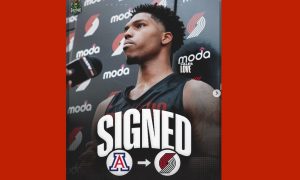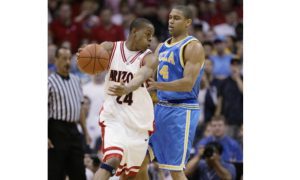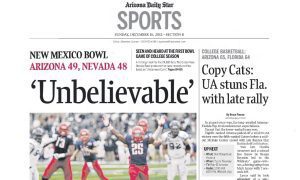|
|
|
ARIZONA PRODUCTIVITY RATING
[table “” not found /]
GLOSSARY:
G: Games played. S: Number of starts.
BP: Bench points. A player gets three points if he is first off the bench, two if second and one if third. Shows Sean Miller’s rotation.
UCLA: Productivity points against UCLA
UMIN: Minutes played against UCLA
PP: Productivity Points (Points, assists, rebounds, steals, blocked shots, FGs made, FTs made added together and then subtracted by missed FGs, missed FTs, personal fouls and turnovers)
TMIN: Minutes played overall
PR: Productivity rating per minute played (Productivity points divided by minutes played)
NOTE: Player must average at least 10 minutes a game to be listed in primary rotation

Jordan Adams had a dominating performance to the end when he broke his right foot in UCLA’s win over Arizona
LAS VEGAS — In in this disjointed season for UCLA and Arizona, the player who impacted Friday’s game the most — UCLA guard Jordan Adams — broke his right foot on the last play of the game in the Bruins’ 66-64 victory. Figures.
That’s unfortunate news for college basketball in general that Adams, who scored 13 consecutive points for UCLA in its second-half comeback, is finished for the season. His 18 points in the second half helped end Arizona senior Solomon Hill’s chance to wear the Pac-12 tournament championship T-shirt and cap Hill talked so much about. Adams, who suffered a broken fifth metatarsal bone, can only watch and hope the Bruins can bring home the Pac-12 hardware.
My colleague Anthony Gimino of TucsonCitizen.com turned to me after the game and mentioned that Adams became another Allen Crabbe or Spencer Dinwiddie, players who became hot and shot down the Wildcats in the second half of the Pac-12 season.
UCLA, which last week lost to last-place Washington State and has eight defeats overall, has a chance to win the Pac-12 regular season and tournament championship with a win over Oregon tonight at the MGM Grand Garden Arena.
“We didn’t have enough defensive fortitude, hanging in there, being able to get that big stop when we really needed it,” Arizona coach Sean Miller explained about the Wildcats’ allowing an 11-point second-half lead to slip away.
Adams had an incredible 37 productivity points in only 29 minutes — it felt like he was on the court for the full 40 minutes — far outperforming every other starter in the game. For the definition of productivity points and rating, please see the glossary.
Adams posted more productivity points than Arizona’s senior starters — Hill, Kevin Parrom and Mark Lyons — who combined for only 33 in 75 minutes. Adams’ aggressive play landed him on the free-throw line 13 times (making 11) while Hill and Lyons did not attempt a single free throw. Adams had more free throws than Arizona (7 of 9 shooting) overall.
|
Two of Adams’ free throw attempts were a result of Miller’s technical foul with 4:37 remaining that tied the game at 56. That was the first tie of the game since 14:04 remained in the first half. Arizona had the lead from that point until the technical. Miller was adamant that he shouted only that Adams touched the ball on a double-dribble call on Lyons. The UA coach also gave credit to UCLA for the victory and said the loss was on him because of the technical. |
|
“My man over here (pointing at Hill on the podium), he’s never coming back here again,” Miller said. “His coach gets a technical foul. Didn’t cuss. Didn’t challenge him (referee Michael Irving). By the way, it’s my first technical foul of the year. That’s what this is about. And by the way, full credit given to UCLA. They did a great job.”
Nobody has heard of Irving until Friday, but UA fans now hold him in the same disdain as Booker Turner, Dave Libbey and Tom Harrington. It was Harrington who called a technical foul on Lute Olson late in the game when UCLA ended Arizona’s 71-game McKale Center winning streak in 1992.
Olson sounded like Miller then. “I said nothing,” Olson told reporters after that game. “I assume it was because I was trying to express something. If you ask me, I think it was retaliation for giving one earlier (to former UCLA coach Jim Harrick, who got one in the first half).”
Arizona sophomore guard Nick Johnson, when asked of the officiating, took the high road.
“I don’t want to talk about the officiating,” he said. “They (the Bruins) have good players. They made good plays.”
Arizona’s young bigs made good plays too, which provides hope for the Wildcats as they rejoin March Madness after a year away last season. Grant Jerrett, Kaleb Tarczewski and Brandon Ashley combined for 50 of Arizona’s 92 productivity points in the game. They played a total of 70 minutes, which means they combined for a productivity rating of .714. That’s normally a winning performance but Arizona’s experienced players struggled.
The freshmen made a statement against UCLA’s more-publicized freshmen — Adams, Shabazz Muhammad and Kyle Anderson. That trio combined for 71 productivity points in 91 minutes, a .780 rating, mostly behind Adams’ production.
“It’s honestly not something we look at,” Ashley said when asked if the UA’s freshmen took at as a challenge playing against UCLA’s publicized freshmen. “We don’t look at a player getting individual accolades. When the team is not winning, none of that matters.”
UCLA is 3-0 against Arizona, the second time the Bruins have achieved that mark against the Wildcats in a season. They also were 3-0 against the UA in 2006. Arizona tried to go 3-0 against the Bruins in 2003 and 2010 but lost both games in the opening round of the Pac-10 tournament.
ARIZONA’S 20-10 CLUB
PLAYERS WHO RANK IN TOP 20 CAREER SCORING/TOP 10 CAREER REBOUNDING
|
[table “” not found /] |
Hill is 17 points from No. 20 career scoring leader Joe Noels, who had 1,409 points from 1976-80. He is four rebounds shy of No. 10 career rebounding leader Jordan Hill (no relation), who produced 763 from 2006-09.
Defensive Rebounding Percentage (DRB%): Determined by dividing Arizona’s defensive rebounds (26 against UCLA) by the opposition’s offensive rebounds (11) added to Arizona’s defensive rebounds (26) — 26/(11 + 26) = 70.3 percent.
Offensive Rebounding Percentage (ORB%): Determined by taking Arizona’s offensive rebound total (11) divided by that total (11) and the defensive rebounds of the opponent (20 for UCLA) — 11/(11 + 20) = 35.5 percent.
Ideal marks are 72 percent DRB% and 38 percent ORB%.
|
DEFENSIVE/OFFENSIVE REBOUNDING% [table “” not found /] |
Site publisher, writer and editor Javier Morales is a former Arizona Press Club award winner
[rps-paypal]
|
|






























